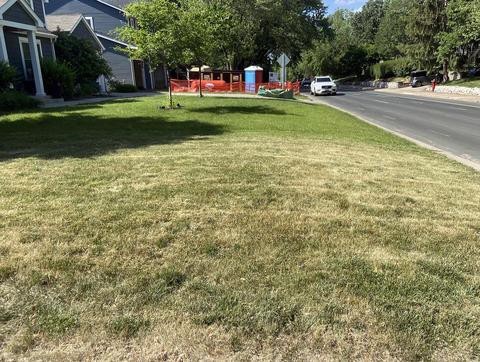Drought Stress

Cool season lawns are starting to show some heat stress, even if they have been watered on a regular basis. Kentucky Bluegrass will start to turn brown and go dormant after 7 days of no water while fescue can make it up to 28 days without water before turning brown. Both grasses can go dormant for 4 to 6 weeks with no water before the grasses will start to die. If you are watering the lawn try to water it once or twice a week and water deeply to encourage the roots to go down in search of water. Watering for a short period of time everyday leads to a shallow root system that doesn’t tolerate drought or heat. If you do decide to let your lawn go dormant still water it approximately a half an inch every week to two weeks to keep the crown and roots alive. That amount of water won’t green up the grass but will keep it alive. Don’t fertilize while the grass is dormant as the fertilizer won’t be taken up by the grass plants. It’s also important to reduce traffic on stressed lawns as much as possible and raise your mowing height to 3-4” for the best grass health.
Recently planted trees and shrubs, those planted within the last year, will need extra care to get established during hot and dry conditions. It takes a tree a minimum of 3-6 months per inch of trunk diameter to become established and the plants will need to be watered twice a week during that time period. Make sure to water the trees deeply and slowly, simply watering for 5-10 minutes with the full force of the garden hose will not be adequate for the tree’s needs. One of the best watering options is to use a 5-gallon bucket with small holes drilled in the bottom to let the water slowly seep into the ground or a similar commercial product (such as pictured to the above) to do a similar task. A soaker hose in a ring around the tree will also work to water the plant slowly. Be sure to mulch newly planted trees and shrubs in, similar to the picture, to reduce the soil temperature and the amount of water that evaporates from the soil.
extra care to get established during hot and dry conditions. It takes a tree a minimum of 3-6 months per inch of trunk diameter to become established and the plants will need to be watered twice a week during that time period. Make sure to water the trees deeply and slowly, simply watering for 5-10 minutes with the full force of the garden hose will not be adequate for the tree’s needs. One of the best watering options is to use a 5-gallon bucket with small holes drilled in the bottom to let the water slowly seep into the ground or a similar commercial product (such as pictured to the above) to do a similar task. A soaker hose in a ring around the tree will also work to water the plant slowly. Be sure to mulch newly planted trees and shrubs in, similar to the picture, to reduce the soil temperature and the amount of water that evaporates from the soil.
Mature trees and shrubs may also need water if hot and dry conditions persist. Keep an eye out for symptoms of drought stress including yellowing and dropping of leaves, dying limbs, leaf scorch, and wilting of leaves both temporarily in the afternoon and permanently in the morning. Another way to check if you need to water mature trees is to dig a hole 6-9 inches deep under the canopy of the tree, if the soil is still damp and cool there is no need to water but if the soil is dry it’s time to consider supplemental water for that plant. The first plants that will likely need water are those that are less resistant to drought such as birch, willow, cottonwood or trees the are native to areas with more moisture. If you are limited on how many plants you can water, consider the value of the tree, both monetarily and emotionally and the size of the tree then water the priority plants first. When you water, be sure to water as much of the tree’s dripline as possible and water deeply. Start by applying 1” of water to the area (use tuna cans with sprinkler systems to help measure how much water has been applied) then dig a 6” deep hole and see if the water has soaked down that far. If it hasn’t, apply another half inch of water and check in another location. Continue to apply approximately 1” of water every week during periods of heat and drought. Morning is the best time to water if possible followed by the evening but avoid watering during the heat of the day to reduce evaporation.

Have questions? Contact our office where our Horticulture Extension Agent will assist you with questions.
Phone: (316) 321-9660
Email: callae@ksu.edu